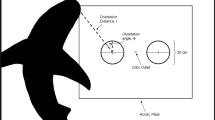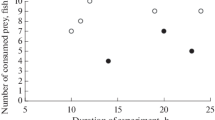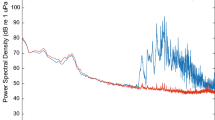Abstract
During their seasonal runs in the Okavango and other freshwater bodies in southern Africa, the sharptooth catfish, Clarias gariepinus, specialises on the bulldog, Marcusenius macrolepidotus, as its main prey. We examined whether the catfish can locate bulldogs by detecting their pulse-type electric organ discharges (EODs). The electrosensory threshold for single-cycle, monopolar square-wave pulses was exceedingly low (down to 13 µVp–p/cm for 4-ms pulses) in trained, food-rewarded sharptooth catfish (n=4), confirming the results of Lissmann and Machin who were, however, unable to identify a biological function. Other stimulus pulse waveforms (single-cycle, monopolar as well as bipolar sine-wave pulses) were also effective stimuli according to their spectral low-frequency energy contents (0– 30 Hz). Male bulldogs display an EOD pulse approximately 10× the duration of female EODs (≈0.5 ms). The C. gariepinus threshold for field-recorded playbacks of a male bulldog EOD (of long duration) was 103 µVp–p/cm, whereas the brief female and juvenile EODs were not detected (using intensities of natural EODs). EODs of other mormyrids were detected when either monopolar or of long duration. Signal source amplitude increased linearly with standard length (SL) in bulldogs. Signal reach, as calculated from signal source amplitude and receiver sensitivity, is up to 150 cm for a large male bulldog (SL 27.5 cm), and 83 cm for a male that has just turned sexually mature (SL 12.6 cm). Therefore, most bulldogs eaten by catfish are probably male, in agreement with the size distribution of bulldogs found in catfish stomachs. These results suggest that sharptooth catfish rely heavily on their acute electrical sense during hunting, and an important function for electroreception in an African catfish has been identified.
Similar content being viewed by others
Author information
Authors and Affiliations
Additional information
Received: 13 December 1999 / Revised: 20 April 2000 / Accepted: 20 May 2000
Rights and permissions
About this article
Cite this article
Hanika, S., Kramer, B. Electrosensory prey detection in the African sharptooth catfish, Clarias gariepinus (Clariidae), of a weakly electric mormyrid fish, the bulldog (Marcusenius macrolepidotus). Behav Ecol Sociobiol 48, 218–228 (2000). https://doi.org/10.1007/s002650000232
Issue Date:
DOI: https://doi.org/10.1007/s002650000232




